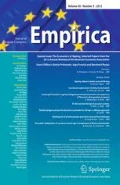Abstract
This paper investigates the relationship between industrial dynamics in terms of firm entry, market turbulence and employment growth. Do entry of firms, the composition of industry dynamics (net entry) and market turbulence (entry and exit) influence industrial employment growth? This paper provides an empirical investigation, using unique data for 42 disaggregated Swedish industrial sectors during the period 1997–2001. It is hypothesised that the importance of entering firms, net entry and market turbulence may differ significantly across industries. A quantile regression method is used in order to detect industrial differences in the response to industrial employment growth. The empirical evidence shows that, on the one hand, firm entry and market turbulence have a positive effect on employment for fast growing industries and that the effect is larger for high growth industries. On the other hand, the composition of industry dynamics in terms of net entry rates has a more dispersed effect across all industries, even though the effect of net entry is larger for high growth industries.
Similar content being viewed by others
Notes
Defined as market turbulence (sum of entry and exit) minus net entry.
Measured as per capita income growth.
The SIC code at the 4-digit level corresponds to NACE Rev. 1.
Financial intermediation (SIC codes 65–67), real estate activities (SIC code 70) and activities of membership organizations (SIC code 91) are not included in the dataset since they are not covered by the collection method applied by Statistics Sweden.
These industries were: extraction of crude petroleum and natural gas (SIC code 11), mining of metal ores (SIC code 13), manufacture of tobacco products (SIC code 16) and collection, purification and distribution of water (SIC code 41).
Note that entry and exit rates are defined according to the ecological approach (see Armington and Acs 2002).
One alternative approach would of course be to estimate different subsets of the data (e.g. high growth, medium growth, and low growth industries) separately. In this way a lot of information will be lost since only a limited number of observations can be used in each regression. The advantage with using the quantile regression is that all observations are used in the estimations.
It might be worth mentioning that in a quantile regression framework there is less need to assign, e.g. industry dummy variables since each quantile is estimated separately.
References
Acs Z, Armington C (2004) Employment growth and entrepreneurial activities in cities. Reg Stud 38(8):911–927
Anthuvan VL (2005) Jobless growth and unemployment: a global phenomenon. World Aff 9(1):62–73
Armington C, Acs Z (2002) The determinants of regional variation in new firm formation. Reg Stud 36(1):33–45
Ashcroft B, Love J (1996) Firm births and employment change in the British counties: 1981–1989. Pap Reg Sci 75(4):483–500
Audretsch DB, Fritsch M (2002) Growth regimes over time and space. Reg Stud 36(2):113–124
Audretsch DB, Thurik AR (2000) Capitalism and democracy in the 21st century: from the managed to the entrepreneurial economy. J Evol Econ 10:17–34
Audretsch DB, Lehmann EE, Warning S (2005) University spillovers and new firm location. Res Policy 34:1113–1122
Bosma N, Nieuwenhuijsen H (2002) Turbulence and productivity: an analysis of 40 Dutch regions in the period 1988–1996. SCALES—paper N200205. EIM Business and Policy Research, Zoetermeer
Braunerhjelm P, Borgman B (2004) Geographical concentration, entrepreneurship and regional growth: evidence from regional data in Sweden 1975–99. Reg Stud 38(8):929–947
Buchinsky M (1998) Recent advantages in quantile regression models. J Hum Resour 33:88–126
Caves RE (1998) Industrial organization and new findings on the turnover and mobility of firms. J Econ Lit 36(4):1947–1982
Davidsson P, Lindmark L, Olofsson C (1994) New firm formation and regional development in Sweden. Reg Stud 28(4):395–410
Davidsson P, Delmar F (2001) Tillväxtföretagen i Sverige: förekomst och utvecklingsmönster (growth firms in Sweden: prevalence and patterns of development). In: Davidsson P, Delmar F, Wiklund J (eds) Tillväxtföretagen i Sverige (growth firms in Sweden). SNS, Stockholm
Fritsch M (1997) New firms and regional employment change. Small Bus Econ 9(5):437–448
Fritsch M, Mueller P (2004) Effects of business formation on regional development over time. Reg Stud 38(8):961–975
Fölster S (2000) Do entrepreneurs create jobs? Small Bus Econ 14(2):137–148
Geroski P (1995) What do we know about entry? Int J Ind Organ 13(4):421–440
Greene WH (2003) Econometric analysis, 5th edn. Prentice Hall, New Jersey
Karlsson C, Friis C, Paulsson T (2005) Relating entrepreneurship to economic growth. In: Johansson B, Karlsson C, Stough RR (eds) The emerging digital economy: entrepreneurship, clusters and policy. Springer, Berlin
Koenker R (2005) Quantile regression. Cambridge University Press, Cambridge
Koenker R, Bassett G (1978) Regression quantiles. Econometrica 46(1):33–50
Nyström K (2006) Entry and exit in Swedish industrial sectors. JIBS Dissertation Series No. 32, Jönköping International Business School, Jönköping
Persson H (2004) The survival and growth of new establishments in Sweden 1987–1995. Small Bus Econ 23:423–440
Schumpeter JA (1934) The theory of economic development. Harvard University Press, Massachusetts
Schumpeter JA (1942) Capitalism, socialism and democracy. Harper & Row, New York
Statistics Sweden (1998) Financial accounts for enterprises 1996. SM9801 NV11. Statistics Sweden, Örebro
van Stel A, Diephuis B (2004) Business dynamics and employment growth: a cross-country analysis. Frontiers of Entrep Res, Babson College
van Stel AJ, Storey DJ (2004) The link between firm births and job creation: is there a Upas tree effect? Reg Stud 38(8):893–909
Wagner J (1994) The post-entry performance of new small firms in German manufacturing industries. J Ind Econ 42(2):141–156
Author information
Authors and Affiliations
Corresponding author
Rights and permissions
About this article
Cite this article
Nyström, K. Entry, market turbulence and industry employment growth. Empirica 36, 293–308 (2009). https://doi.org/10.1007/s10663-008-9086-z
Published:
Issue Date:
DOI: https://doi.org/10.1007/s10663-008-9086-z


